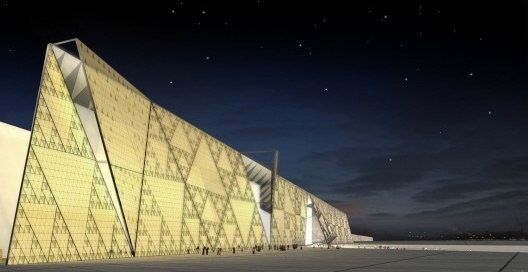
Grande Museu Egípcio/Grand Egyptian Museum, Cairo, Egito/Egypt. Heneghan Peng Arquitetos/Heneghan Peng Architects
Archimation [www.hparc.com]
Maycon Sedrez: Have you worked in a design which was generated with fractals or recursivity?
Florian Gauss: There was one which went quite far, is a façade which is part of the Grand Egyptian Museum in Cairo in front of the pyramids. You may know this design. Heneghan Peng are the architects from Dublin. This is a simple fractal the Sierpinski sieve which is of course a very nice and rational principle, creates a reciprocal grid adaptable to any triangle. It is quite a strong simple approach. I wouldn’t say this is a very complex shape, is not really complex. It is rigorous and generates interesting visual form. Structurally you can say it is a sensible, is not something which is optimized; however it has a fairly useable internal organization for a structure. One beam spanning on the other one. Probably not the most efficient one, if you do it out of flat steel. However it always a trade of, needs to be a balance between your design inspirations, the methods which you have available for fabrication, of course structural and other impacts which are relative to your aspirations.
MS: Actually, I am studying the Grand Egyptian Museum for my thesis. Do you have some information that you could share about the design or details about the project?
FG: Of course they are all geometrically related. You know the story: panels, Sierpinski iterations, in the middle a cable net. You got six generations, in the middle you have the largest triangles which are always left open, and they will receive a cable net. The really nice thing is that the structural way of working is expressed in the hierarchy and in the depths of the beams. Because you have always the smaller hierarchy beam spanning on the higher hierarchy beam. You have large beams and the next ones are shorter, so they are smaller, they span on each other and they get smaller and smaller. Because the span of the beams always gets smaller, therefore the beam itself can be smaller. Has a real strong inner logic. Of course therefore you can put them on different levels; they are not on the same layer. They are all, as you probably know in a different layer. Which gives you this plastic 3D effect emphasizing the hierarchy of members.
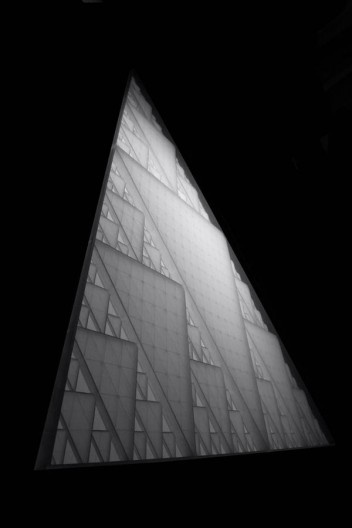
Grande Museu Egípcio/Grand Egyptian Museum, detalhe da fachada/façade detail, Cairo, Egito/Egypt. Heneghan Peng Arquitetos/Heneghan Peng Architects
Richard Davies [www.hparc.com]
Of course, we develop the script which first generates the fractal geometry of the Sierpinski triangle, which is pretty simple. There is this Pascal Triangle which gives you the entire map of the Sierpinski subdivision and it is a series of numbers. So this is kind of the most sophisticated way, but you also can do it completely simple geometric, just take the half of the edges of the triangle and place a point there. Both methods are going to give you the same result. Then you have the geometry, and the geometry is the only input, you need three points. I also gave the profiles a direction, because we wanted to orient the profiles towards the non-orthogonal grid system of the main building.
Here, you can also give the profiles of different generations. You give the member dimensions, because the triangles are getting smaller when you go along the wall. They are going to change in size, therefore you need to give them different dimensions. The script is prepared to generate all the different pieces. Also we played around with the cable nets in two directions or three directions, and density as half, so not having in every generation a cable. So you can give the steel sections already which we programed also the loads and the pre-stress of the cables.
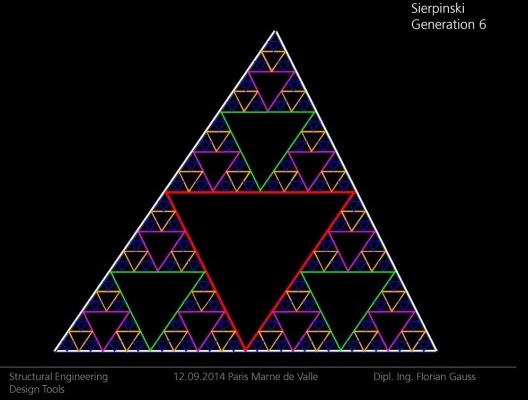
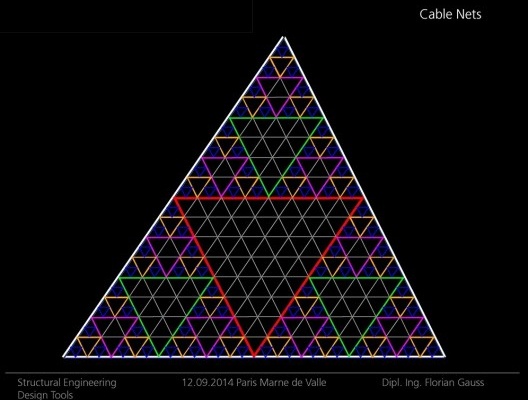
Geração 6 de Sierpinski e a rede de cabos/Generation 6 Sierpinski and Cable Nets
Florian Gauss, 2015
This is how it is going to look like, is the Pascal Triangle so it is a very simple formula. Where the number of triangles are generated depending on how much Sierpinski generations you want. That is the stick model which is generated automatically from our code, so the brown elements are the pre-stressed cables, the green ones are the bars. Now because they have the different structure system all structural loads are not in one plane, they are somehow offsetted. This is something it is considered here, you can see, the structural software has a specific functionality that you can connect nodes together. What we did is each Sierpinski generation adds his own node, on different layers where it has to say and then we connect them rigidly together. When you see here look like they are flying, but then there is a way in the structural software you can say: consider rigid constraint, take all the nodes together and treat them as one node. But it is considering all the eccentricities, because that is quite a complex thing. And that is the whole entire façade.
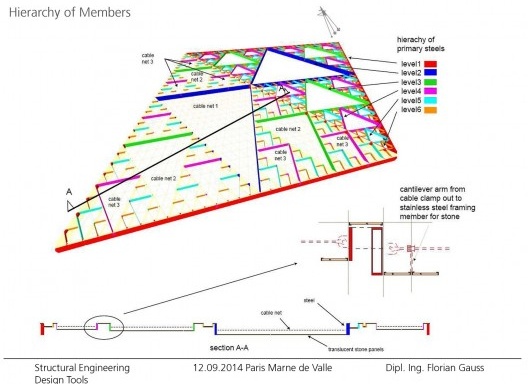
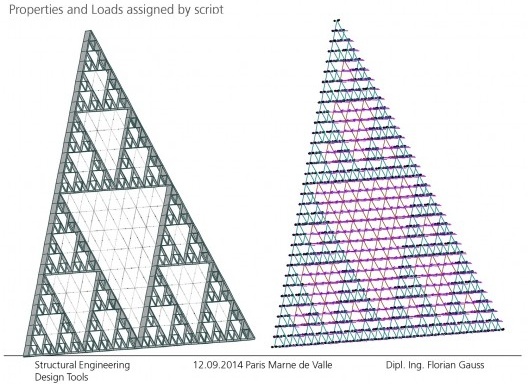
Hierarquia dos membros e propriedades e cargas/Hierarchy of members and properties and loads
Florian Gauss, 2015



